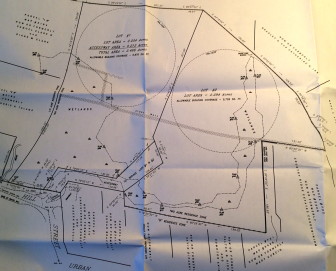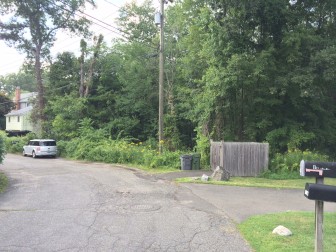Saying the proposed subdivision of a long-unused, sloping 4.76-acre lot on Hill Street will exacerbate runoff, lower property values and do nothing for the aesthetics of an already “forgotten” New Canaan neighborhood, an attorney for one neighbor is calling for a new engineering design and plans.

Here’s part of the general plan for Lot 72 on Hill Street, including about where a pair of homes could be located. Concerned about the effect that the home on the right would cause for downland properties along Urban Street, town officials are asking whether the driveway itself could be shifted to the left, allowing the home on the right to be located further away.
Hill Street is windy road of 10 modest houses and condos that runs just above and roughly parallel to Route 123 for about 500 feet, just east of Brushy Ridge Road. Developers have put forward a plan to subdivide into two what is called “Lot 72”—a thickly wooded property located within the Fivemile River watershed that’s belonged to the same family since it was purchased for $19,500 in 1966, tax records show.
Plans call for two single-family residences with a single, shared access driveway from Hill Street. The Inland Wetlands Commission on June 30 approved the driveway on several conditions. A single driveway would be needed—as opposed to two, say—since the piece of Lot 72 that fronts Hill Street is a narrow strip of land wedged between numbers 11 and 37—see map that follows where number 11 is designated, article continues below:
Heather Brown, an attorney speaking at the Aug. 26 Planning & Zoning Commission meeting on behalf of an objecting neighbor—at number 11—said Hill Street “appears to be one of the streets in New Canaan that time forgot and the DPW forgot.”
“As it currently stands right now, it is in horrendous condition,” Brown said at the public hearing, held in the Douglas Room at Lapham Community Center. “The asphalt is torn up, there are dirt patches, it’s very narrow, it’s overgrown and the wetlands right now are being used as dumping grounds. What I am proposing, ladies and gentlemen, is with a very, very aggressive engineering design and environmental buffer we now have an opportunity to reclaim one of our streets, to bring that street up to the standards we are accustomed to as residents of New Canaan, where it’s attractive, it’s functional, it doesn’t invite dumping, and I think it will be very much in accord with the purpose and intent of the 2014 Plan of Conservation and Development, as recently adopted.”

Here we’re looking roughly westward, toward the bend in Hill Street. Just before where the SUV is parked would be where a driveway would go into the 4.76-acre lot on the right. It’s undeveloped now, and much of it appears to be a maple and birch forest. Credit: Michael Dinan
The commission took no action at the meeting, though its members had many questions for both Brown and the proponents of subdivision.
Speaking on behalf of the application to subdivide were attorney Patricia C. Sullivan of Bridgeport-based Cohen and Wolf and Steve McAllister of Wilton-based McChord Engineering Associates, Inc. Asked whether they would submit to conservation easements on the property, Sullivan said no, especially “not knowing exactly what will be on the properties.”
P&Z Chairman Laszlo Papp clarified by asking, “Essentially your position is that nature provided in wetlands its own conservation easement?”—to which Sullivan answered yes.
A January report from McChord said that the development will increase the impervious area on the lots, and attendant storm water and runoff.
“Roof and driveway runoff under proposed conditions will be collected by the proposed roof leader and driveway drainage systems and drain into the proposed detention systems,” the report said. “The remaining site runoff will sheet flow to the south and ultimately enter the wetland and watercourse system … The proposed development will approximately maintain existing drainage patterns and will not adversely affect the site or the surrounding areas.”
Brown argued that neighbors along Urban Street—contiguous along the property’s southern edge—have no adequate or effective buffer, adding that a fence with proposed holly bushes won’t do.
“The last thing Hill Street needs is another boxed-in screening fence,” Brown said.
She also said that sloping Lot 72 should get at most one home, not two: “We would suggest that based upon the wetlands as currently situated on this property that it gives rise to support the lowest density which would be one structure on a four-acre lot, not two structures on a four-acre lot.”
Town Planner Steve Kleppin suggested that the proposed property line within the subdivision move west, allowing for more space between the home that would go up directly upland from the row of Urban Street houses and those properties.
McAllister said he would look at whether it’s possible.
P&Z is next scheduled to meet Sept. 23.